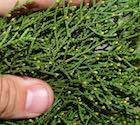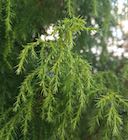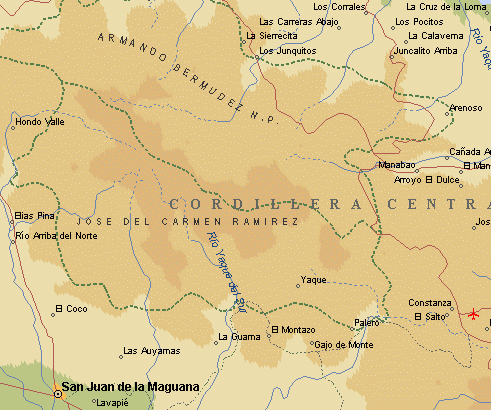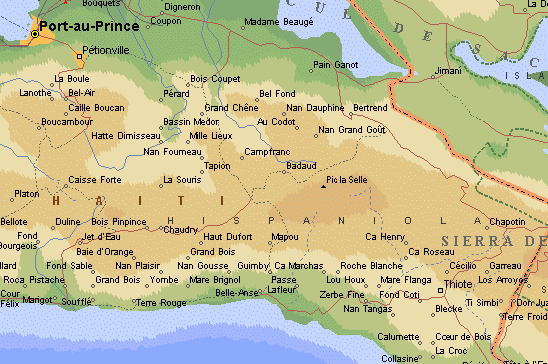Conservation Status
 (var. gracilior)
(var. gracilior)
 (var. ekmanii)
(var. ekmanii)
 (var. saxicola)
(var. saxicola)
 (var. urbaniana)
(var. urbaniana)
Juniperus gracilior
Pilg. ex Urban 1913
Common names
Hispaniolan juniper; cèdre [French]; sabina [Spanish].
Taxonomic notes
Juniperus, Section Sabina. There are four varieties:
- J. gracilior var. gracilior.
- J. gracilior var. ekmanii (Florin) R.P.Adams 1995. Syn: J. ekmanii Florin 1934 (Farjon 1998).
- J. gracilior var. saxicola (Britton & P.Wilson) R.P.Adams 2012. Syn: J. saxicola Britton & P.Wilson 1923; J. barbadensis L. subsp. saxicola (Britton & P.Wilson) Borhidi 1992; J. barbadensis L. var. saxicola (Britton & P.Wilson) Silba 2000.
- J. gracilior var. urbaniana (Pilg. & Ekman) R.P.Adams 1995. Syn.: J. urbaniana Pilg. et Ekman 1926, J. barbadensis var. urbaniana (Pilg. et Ekman) Silba 1984, J. barbadensis subsp. urbaniana (Pilg. et Ekman) Borhidi 1992 (Farjon 1998).
Leaf terpenoid data indicate that, as with the other Caribbean junipers J. barbadensis and J. bermudiana, this species is closely related to J. virginiana, a widely distributed species of the eastern U.S. (Adams 2008).
Each of the subspecies was originally described as a different species. Vars. gracilior and ekmanii are most similar, var. urbaniana differs in having thick twigs and a shrub habit, and var. saxicola is most distinct in having reverted to needle-like foliage. This is an example of neoteny and occurs in 5 species in Section Sabina (the others being J. coxii, J. recurva, J. morrisonicola and J. squamata). Despite these morphological differences, DNA sequencing has shown the varieties of J. gracilior to be extremely similar and to be tightly clustered relative to the other species in the J. virginiana complex, of which J. barbadensis is the nearest relative (Adams and Schwarzbach 2012, Adams 2014). Adams (2014) proposes that the Caribbean junipers arose from long distance bird dispersal of J. virginiana seeds from North America, first to the Bahamas, and then to Bermuda, Cuba, Jamaica, and Hispaniola. Var. saxicola likely evolved from Cuban populations of J. barbadensis var. lucayana, with the neotenic state likely originating from founder's effect or genetic drift, both of which would have been associated with a very small population size, consistent with the modern very limited distribution of this species. Based on our knowledge of sea level and geologic change in the Caribbean, all of this likely happened during Pleistocene time (the past 1.8 million years). See Adams (2014) for a recent review emphasizing molecular and chemosystematic relationships within this species complex, and also see the pages for these other species in the complex.
Description
Dioecious evergreen shrubs or trees to 15 m tall and 40 cm dbh, typically with a single erect trunk, spreading or ascending branches, and a rounded or irregular crown. Bark brown, thin, exfoliating in strips or plates, turning gray-brown with age. Except in var. saxicola (see below) twigs are numerous, mostly branching from larger twigs at 20-45° angles, current year twigs mostly <20 mm long, 0.9-1.5 mm thick, generally quadrangular; leaves are green, scale-like, opposite in 4 ranks, decurrent, imbricate with a free apex, 1.5-2 × 0.6-1 mm, rhombic to rhombic-lanceolate, margins entire and hyaline, apex obtuse to acuminate, abaxial stomata few and basal, adaxial stomata in concavity, one rounded to oval abaxial gland in basal to central part of leaf. Pollen cones terminal, subglobose, ca. 2 mm long. Seed cones terminal, maturing in one season, globose to pear- or kidney-shaped, 4-5 mm wide, soft pulpy, resinous, glaucous, dark blue or reddish brown at maturity, with 1-2 ovoid, light brown seeds 2-3 mm long per cone (Farjon 2010).
The varieties are distinguished as follows (Adams 1995, Farjon 2010):
- Var. gracilior: Trees. Current year twigs spreading at <30°, drooping, 0.9-1.1 mm diameter, leaves definitely longer than wide, obtuse to acuminate, with a central gland; ripe seed cones reddish-brown.
- Var. ekmanii: Trees. Current year twigs spreading at 30-45°, 0.9-1.1 mm diameter, leaves slightly longer than wide, acuminate or mucronate, with a conspicuous basal gland; ripe seed cones reddish-brown.
- Var. saxicola: Tree or shrub. Leaves always needle-like, decurrent, spreading, 5-7 × 1 mm, scale leaves never present on adult trees; ripe seed cones dark blue.
- Var. urbaniana: Shrubs. Current year twigs spreading, curved, stiff, thick (1.3-1.5 mm diameter), leaves slightly shorter than wide, mucronate, glands basal but often inconspicuous; ripe seed cones reddish-brown.
Distribution and Ecology
Native to Cuba, and Hispaniola: Haiti and Dominican Republic, at elevations of 1000-2550 m in humid montane forest with abundant epiphytes. At most locations the forest has been severely degraded and largely replaced by secondary vegetation, mainly Pteridium aquilinum (bracken fern). The junipers are mainly isolated individuals; at each location both the area of occurrence and the population size are small (Farjon 2010).
J. gracilior var. gracilior is found in the Dominican Republic: La Vega province, near Costanza and the Valle del Yaque (18°56' N, 70°56' W), at 1000-1700 m elevation on acidic forest soils. The IUCN has assigned it "Endangered" status. Although still relatively common in western parts of the Dominican Republic, it is in continuous decline due to cutting for firewood and clearing of land for pasture. Its habitat is not protected and there are no conservation programs in place (Farjon 1998, 2013a).
J. gracilior var. ekmanii: Haiti: Pic la Selle and Morne la Visite; the Dominican Republic: Sierra Baoruco. Occurs at 1330-2100 m elevation on acidic forest soils. The IUCN has assigned it "Critically Endangered" status. Only a few trees remain, and cutting for its valuable wood as well as for firewood (branches) continues. Seed cones have never been collected, so it is probably regenerating very poorly and few if any female trees may still exist. Robert Adams found only two surviving trees on a visit in 1995 to Morne la Selle. The number of mature trees in the Dominican Republic is also small but not known. In Haiti it occurs in a National Park, but this is a nominal form of protection due to lack of management and policing. No conservation plans exist (Farjon 1998, 2013b).
J. gracilior var. saxicola: is endemic to Cuba: Granma Province: on the rocky crests of the Sierra Maestra and Pico Turquino (Adams 1995). Farjon (2005) calls this habitat a xeromorphic variant of cloud forest, and says that the juniper prevails where rocky terrain precludes dominance of co-occurring species such as Cleyera ekmannii, Clusia tetrastigma, Haenianthus salicifolius, Lyonnia turquini, and Ternstroemia microcalyx. The IUCN lists this species as critically endangered due to a decreasing population status. The population is restricted to three mountain tops: Pico Cuba, Pico Real del Turquino, Pico Regino. These peaks are in very close proximity to each other (between 1-3 km apart) and the total population consists of only 53 mature individuals. The sites are protected but remain at risk from human activity, fire or fire suppression, and invasive pests and pathogens (Torres et al. 2013).
J. gracilior var. urbaniana: Haiti: Pic la Selle, near the summit on limestone at 2,300-2,500 m elevation; and nearby in the Dominican Republic: Sierra de Baoruco, in a field at 2,100 m elevation. The IUCN has assigned it "Endangered" status. The total population is likely less than 250 individuals, and no more than 30 plants in Haiti. The Haiti population is known to be declining, while the Dominican Republic population was only recently discovered, so no population trend can be discerned. Fire and possibly livestock grazing are contributing decline. About a third of the Dominican Republic population is protected within a national park, but no conservation plans exist for the species (Farjon 2013c).
Remarkable Specimens
No data as of 2023.03.03.
Ethnobotany
On Hispaniola, the wood is used for furniture and carving, and for firewood. In Haiti, where it does not occur in the wild, var. gracilior is planted as an ornamental tree (Farjon 2013a, 2013c).
Observations
For var. saxicola, representative specimens have been collected at the Cueva del Aura on Sierra Maestra, and on Pico Turquino (20° N, 17°50' W) at 1600-1700 m elevation on the steep rocks of Loma Regiona (the Pico's north spur) and on the summit of the Pico (Adams 1995). Pico Turquino is the highest point in Cuba, and the area has been preserved in Parque Nacional Turquino.
Remarks
The epithet gracilior means "slender", and saxicola is from saxum, "rock", and colere, "to grow". Var. ekmanii honors Swedish botanist E. L. Ekman (1883-1931), who collected the type speciments of var. ekmani and var. urbaniana. Var. urbaniana honors German botanist Ignatz Urban (1848-1931), authority on Caribbean botany.
Citations
Adams, Robert P. 1995. Revisionary study of Caribbean species of Juniperus (Cupressaceae). Phytologia 78(2):144. Available: Biodiversity Heritage Library, accessed 2022.12.26.
Adams, Robert P. 2014. Junipers of the World: The Genus Juniperus. Fourth edition. Trafford Publishing. Brief versions of the descriptions are available online at Adam's website, www.juniperus.org.
Adams, R. P., and A. E. Schwarzbach. 2012. Taxonomy of the multi-seeded, entire leaf taxa of Juniperus section Sabina: sequence analysis of nrDNA and four cpDNA regions. Phytologia 94:350-368.
Britton, N. L. and P. Wilson. 1923. Bulletin of the Torrey Botanical Club 50:35.
Farjon, A. 2013a. Juniperus gracilior var. gracilior. The IUCN Red List of Threatened Species 2013: e.T32517A2821155. https://dx.doi.org/10.2305/IUCN.UK.2013-1.RLTS.T32517A2821155.en, accessed on 2022.12.26.
Farjon, A. 2013b. Juniperus gracilior var. ekmanii. The IUCN Red List of Threatened Species 2013: e.T39150A2886864. https://dx.doi.org/10.2305/IUCN.UK.2013-1.RLTS.T39150A2886864.en, accessed on 2022.12.26.
Farjon, A. 2013c. Juniperus gracilior var. urbaniana. The IUCN Red List of Threatened Species 2013: e.T39151A2886899. https://dx.doi.org/10.2305/IUCN.UK.2013-1.RLTS.T39151A2886899.en, accessed on 2022.12.26.
Torres, R. G. L., Adams, R. P. and Gardner, M. 2013. Juniperus saxicola. The IUCN Red List of Threatened Species 2013: e.T31618A2806956. https://dx.doi.org/10.2305/IUCN.UK.2013-1.RLTS.T31618A2806956.en, accessed 2020.01.30.
Urban, I. 1913. Symbolae Antillanae 7(4):481. Available: Biodiversity Heritage Library, accessed 2022.12.26.
See also
This episode of Crime Pays But Botany Doesn't features footage of var. urbaniana in habitat (around 6:40-7:00 in the video).
The species account at Threatened Conifers of the World.
Farjon (2005) provides a detailed account, with illustrations.










